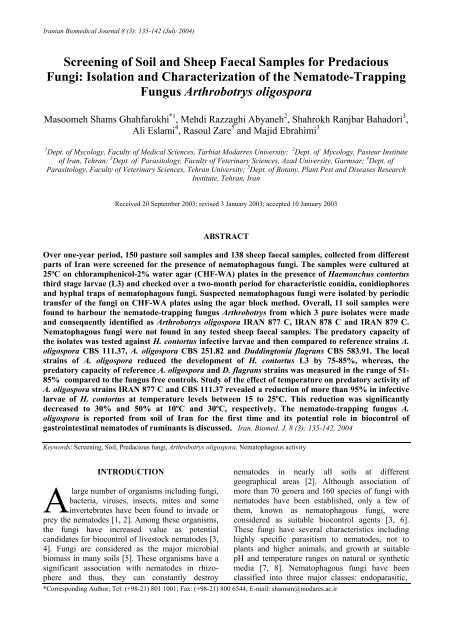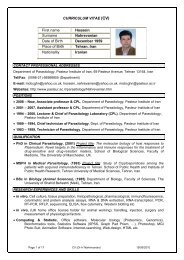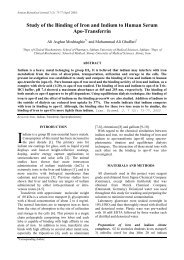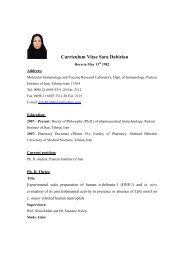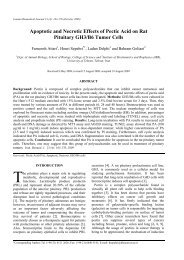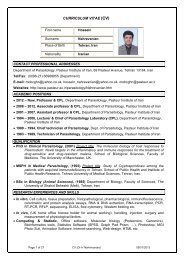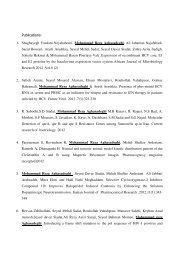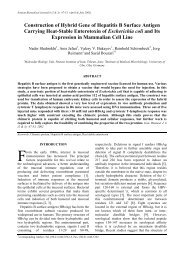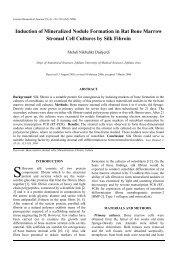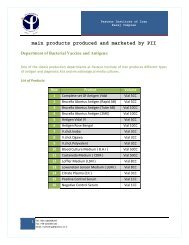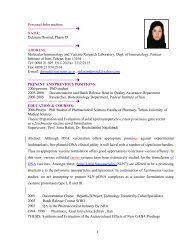Screening of Soil and Sheep Faecal Samples for Predacious Fungi ...
Screening of Soil and Sheep Faecal Samples for Predacious Fungi ...
Screening of Soil and Sheep Faecal Samples for Predacious Fungi ...
Create successful ePaper yourself
Turn your PDF publications into a flip-book with our unique Google optimized e-Paper software.
Iranian Biomedical Journal 8 (3): 135-142 (July 2004)<br />
<strong>Screening</strong> <strong>of</strong> <strong>Soil</strong> <strong>and</strong> <strong>Sheep</strong> <strong>Faecal</strong> <strong>Samples</strong> <strong>for</strong> <strong>Predacious</strong><br />
<strong>Fungi</strong>: Isolation <strong>and</strong> Characterization <strong>of</strong> the Nematode-Trapping<br />
Fungus Arthrobotrys oligospora<br />
Masoomeh Shams Ghahfarokhi *1 , Mehdi Razzaghi Abyaneh 2 , Shahrokh Ranjbar Bahadori 3 ,<br />
Ali Eslami 4 , Rasoul Zare 5 <strong>and</strong> Majid Ebrahimi 3<br />
1 Dept. <strong>of</strong> Mycology, Faculty <strong>of</strong> Medical Sciences, Tarbiat Modarres University; 2 Dept. <strong>of</strong> Mycology, Pasteur Institute<br />
<strong>of</strong> Iran, Tehran; 3 Dept. <strong>of</strong> Parasitology, Faculty <strong>of</strong> Veterinary Sciences, Azad University, Garmsar; 4 Dept. <strong>of</strong><br />
Parasitology, Faculty <strong>of</strong> Veterinary Sciences, Tehran University; 5 Dept. <strong>of</strong> Botany, Plant Pest <strong>and</strong> Diseases Research<br />
Institute, Tehran, Iran<br />
Received 20 September 2003; revised 3 January 2003; accepted 10 January 2003<br />
ABSTRACT<br />
Over one-year period, 150 pasture soil samples <strong>and</strong> 138 sheep faecal samples, collected from different<br />
parts <strong>of</strong> Iran were screened <strong>for</strong> the presence <strong>of</strong> nematophagous fungi. The samples were cultured at<br />
25ºC on chloramphenicol-2% water agar (CHF-WA) plates in the presence <strong>of</strong> Haemonchus contortus<br />
third stage larvae (L3) <strong>and</strong> checked over a two-month period <strong>for</strong> characteristic conidia, conidiophores<br />
<strong>and</strong> hyphal traps <strong>of</strong> nematophagous fungi. Suspected nematophagous fungi were isolated by periodic<br />
transfer <strong>of</strong> the fungi on CHF-WA plates using the agar block method. Overall, 11 soil samples were<br />
found to harbour the nematode-trapping fungus Arthrobotrys from which 3 pure isolates were made<br />
<strong>and</strong> consequently identified as Arthrobotrys oligospora IRAN 877 C, IRAN 878 C <strong>and</strong> IRAN 879 C.<br />
Nematophagous fungi were not found in any tested sheep faecal samples. The predatory capacity <strong>of</strong><br />
the isolates was tested against H. contortus infective larvae <strong>and</strong> then compared to reference strains A.<br />
oligospora CBS 111.37, A. oligospora CBS 251.82 <strong>and</strong> Duddingtonia flagrans CBS 583.91. The local<br />
strains <strong>of</strong> A. oligospora reduced the development <strong>of</strong> H. contortus L3 by 75-85%, whereas, the<br />
predatory capacity <strong>of</strong> reference A. oligospora <strong>and</strong> D. flagrans strains was measured in the range <strong>of</strong> 51-<br />
85% compared to the fungus free controls. Study <strong>of</strong> the effect <strong>of</strong> temperature on predatory activity <strong>of</strong><br />
A. oligospora strains IRAN 877 C <strong>and</strong> CBS 111.37 revealed a reduction <strong>of</strong> more than 95% in infective<br />
larvae <strong>of</strong> H. contortus at temperature levels between 15 to 25ºC. This reduction was significantly<br />
decreased to 30% <strong>and</strong> 50% at 10ºC <strong>and</strong> 30ºC, respectively. The nematode-trapping fungus A.<br />
oligospora is reported from soil <strong>of</strong> Iran <strong>for</strong> the first time <strong>and</strong> its potential role in biocontrol <strong>of</strong><br />
gastrointestinal nematodes <strong>of</strong> ruminants is discussed. Iran. Biomed. J. 8 (3): 135-142, 2004<br />
Keywords: <strong>Screening</strong>, <strong>Soil</strong>, <strong>Predacious</strong> fungi, Arthrobotrys oligospora, Nematophagous activity<br />
INTRODUCTION<br />
A<br />
large number <strong>of</strong> organisms including fungi,<br />
bacteria, viruses, insects, mites <strong>and</strong> some<br />
invertebrates have been found to invade or<br />
prey the nematodes [1, 2]. Among these organisms,<br />
the fungi have increased value as potential<br />
c<strong>and</strong>idates <strong>for</strong> biocontrol <strong>of</strong> livestock nematodes [3,<br />
4]. <strong>Fungi</strong> are considered as the major microbial<br />
biomass in many soils [5]. These organisms have a<br />
significant association with nematodes in rhizophere<br />
<strong>and</strong> thus, they can constantly destroy<br />
nematodes in nearly all soils at different<br />
geographical areas [2]. Although association <strong>of</strong><br />
more than 70 genera <strong>and</strong> 160 species <strong>of</strong> fungi with<br />
nematodes have been established, only a few <strong>of</strong><br />
them, known as nematophagous fungi, were<br />
considered as suitable biocontrol agents [3, 6].<br />
These fungi have several characteristics including<br />
highly specific parasitism to nematodes, not to<br />
plants <strong>and</strong> higher animals, <strong>and</strong> growth at suitable<br />
pH <strong>and</strong> temperature ranges on natural or synthetic<br />
media [7, 8]. Nematophagous fungi have been<br />
classified into three major classes: endoparasitic,<br />
*Corresponding Author; Tel: (+98-21) 801 1001; Fax: (+98-21) 800 6544; E-mail: shamsm@modares.ac.ir
Shams Ghahfarokhi et al.<br />
Table 1. Geographical sites <strong>of</strong> collected soil samples investigated <strong>for</strong> the presence <strong>of</strong> nematophagous fungi in Iran*.<br />
Region Locality Number <strong>of</strong> positive samples Nematophagous fungal isolates<br />
Maz<strong>and</strong>aran<br />
Savadkooh 2<br />
A. oligospora IRAN 877 C<br />
Arthrobotrys sp. (lost)<br />
Ghaemshahr 1 Arthrobotrys sp. (lost)<br />
North-east Noor 2<br />
A. oligospora IRAN 878 C<br />
Arthrobotrys sp. (lost)<br />
Amirkela 1 Arthrobotrys sp. (lost)<br />
South-west Noor 2 Arthrobotrys sp. (lost)<br />
South-east Noor 1 A. oligospora IRAN 879 C<br />
Sisangan <strong>for</strong>est 1 Arthrobotrys sp. (lost)<br />
Garmsar Hosseinabad 1 Arthrobotrys sp. (lost)<br />
*Five samples collected from each location in both regions. The number <strong>of</strong> 13 <strong>and</strong> 9 locations from Maz<strong>and</strong>aran <strong>and</strong> Garmsar were<br />
negative <strong>for</strong> nematophagous fungi, accordingly (details not included in Table).<br />
predacious <strong>and</strong> opportunistic groups. There are<br />
more than 50 species <strong>of</strong> predacious fungi that able<br />
to capture <strong>and</strong> kill nematodes in soil [2, 4]. These<br />
fungi have mainly been classified in some different<br />
genera <strong>of</strong> Hyphomycetes, which are susceptible to<br />
antagonism from other soil fungi [9]. The genera<br />
Arthrobotrys <strong>and</strong> Duddingtonia are considered to be<br />
the most important nematophagous fungi which<br />
intensively studied regarding their ecology <strong>and</strong><br />
pathophysiology, especially in nematode management<br />
programmes [2-4]. Because <strong>of</strong> drug resistance<br />
<strong>and</strong> other problems, such as drug residues in animal<br />
tissues <strong>and</strong> also pastures which resulted from<br />
intensive use <strong>of</strong> anthelmintic treatment in livestock<br />
farms, the dem<strong>and</strong>s <strong>for</strong> application <strong>of</strong> nematode<br />
biocontrol agents i.e. nematophagous fungi in field<br />
managing programmes have been increased rapidly<br />
in recent years [10-17]. Since nematophagous fungi<br />
are common soil habitants, they can be ingested by<br />
animals grazing in pastures <strong>and</strong> then recycle in the<br />
environment after excretion into the animal feces.<br />
There are some reports on the isolation <strong>and</strong><br />
characterization <strong>of</strong> nematophagous fungi from<br />
various sources including soil, dung, compost <strong>and</strong><br />
fresh feces <strong>of</strong> some animal species at<br />
different geographical areas [10, 18-23]. This<br />
communication presents the results <strong>of</strong> a survey<br />
conducted in two temprate-moist (Maz<strong>and</strong>aran) <strong>and</strong><br />
warm-dry (Garmsar) regions <strong>of</strong> Iran with the aim <strong>of</strong><br />
isolation <strong>of</strong> nematophagous fungi from soil <strong>and</strong><br />
fresh sheep faecal samples <strong>and</strong> characterization <strong>of</strong><br />
their predatory activity in vitro. This is the first<br />
report on the isolation <strong>and</strong> characterization <strong>of</strong> a<br />
nematode-trapping fungus named Arthrobotrys<br />
oligospora from Iran.<br />
136<br />
MATERIALS AND METHODS<br />
Sampling sites. One-hundred <strong>and</strong> fifty pasture<br />
soil samples (100 g each) were collected from<br />
different parts <strong>of</strong> Maz<strong>and</strong>aran <strong>and</strong> Garmsar, which<br />
belonged to the moist <strong>and</strong> dry regions <strong>of</strong> Iran,<br />
respectively during April 2002 (Table 1). Five<br />
samples were taken from each location in both<br />
regions <strong>and</strong> then rapidly transferred into the nylon<br />
bags <strong>and</strong> sent to the laboratory. Also, one-hundred<br />
<strong>and</strong> thirty eight faecal samples (50 g each) were<br />
collected directly from rectum <strong>of</strong> different sheep<br />
herds in both regions.<br />
Culture media. Primary isolation <strong>of</strong> nematophagous<br />
fungi was achieved using chloramphenicol-2%<br />
water agar (CHF-WA) medium. This<br />
medium consisted <strong>of</strong> chloramphenicol (0.05%,<br />
dissolved in ethanol), Difco agar (2%) <strong>and</strong><br />
demineralized water (1 L). All ingradients were<br />
mixed in an Erlenmeyer flask <strong>and</strong> divided into 10-<br />
cm diameter Petri dishes after autoclaving <strong>for</strong> 15<br />
min at 121ºC. CHF-WA was also used <strong>for</strong><br />
subsequent isolation <strong>and</strong> subculturing <strong>of</strong> the fungi.<br />
The fungal isolates were maintained on potatodextrose<br />
agar (PDA, Difco) plates.<br />
Nematodes. An experimentally infected lamb<br />
donor was used as a source <strong>of</strong> H. contortus third<br />
stage larvae (L3). This donor was first treated with<br />
albendazole (0.5 mg/kg twice a week) <strong>and</strong><br />
immediately after treatment, a total number <strong>of</strong> 150<br />
adult male <strong>and</strong> female H. contortus were surgically<br />
putted into the abomasum. The faecal samples<br />
contained only H. contortus eggs. After 1 week
Iranian Biomedical Journal 8 (3): 135-142 (July 2004)<br />
incubation <strong>of</strong> the faecal cultures at 25-27ºC, L3 was<br />
harvested by Baermann technique [24]. H. contortus<br />
L3 was throughly washed in sterile water be<strong>for</strong>e<br />
adding to the fungal cultures.<br />
Isolation <strong>and</strong> identification procedures. Isolation<br />
<strong>of</strong> the nematophagous fungi from soil was<br />
per<strong>for</strong>med according to Larsen et al. [10]. Each soil<br />
sample (10 g) was suspended in 50 ml distilled<br />
water in a 250-ml Erlenmeyer flask. The flasks<br />
were vigorously shaked <strong>for</strong> 30 min <strong>and</strong> maintained<br />
<strong>for</strong> an extra 10 min in static condition at room<br />
temperature. Consequently, 4 supernatant samples<br />
(1 ml each) were separately spread on CHF-WA<br />
plates. For faecal samples, 2 g <strong>of</strong> each sample was<br />
throughly homogenized <strong>and</strong> then directly cultured<br />
on 2% water agar plates. After 3 days incubation <strong>of</strong><br />
the soil <strong>and</strong> faecal cultures at 25ºC, approximately<br />
500-1000 H. contortus larvae were added to each<br />
plate. The plates were maintained at 25ºC <strong>for</strong> 2<br />
months in order to demonstrate growth <strong>of</strong><br />
nematophagous fungi. During this period, the plates<br />
were monitored 3-4 times a week <strong>for</strong> the presence<br />
<strong>of</strong> fungi using a stereomicroscope. Characteristic<br />
conidia or traps <strong>of</strong> nematophagous fungi were<br />
repeatedly subcultured on fresh CHF-WA plates by<br />
transferring 2 × 2 mm culture pieces using agar<br />
block technique [25]. Pure cultures were obtained<br />
<strong>for</strong> each isolate using a method named hyphal<br />
tipping [25]. The identification <strong>of</strong> nematophagous<br />
fungi was based on the morphology <strong>of</strong> trapping<br />
structures <strong>and</strong> conidia [26, 27]. The fungi A.<br />
oligospora CBS 111.37, A. oligospora CBS 251.82<br />
<strong>and</strong> D. flagrans CBS 583.91 were obtained from<br />
Centraalbureau voor Schimmelcultures, Baarn (The<br />
Netherl<strong>and</strong>s) <strong>and</strong> were used as reference strains <strong>for</strong><br />
confirmation <strong>of</strong> identity.<br />
infective larvae [3]. The strains were cultivated on<br />
PDA plates at 25ºC <strong>for</strong> 15 days. The surface <strong>of</strong> the<br />
cultures was washed throughly with distilled water<br />
containing 0.02% Tween 80, <strong>and</strong> the number <strong>of</strong><br />
conidia was calculated using a Neubauer (Haemocytometer)<br />
slide under the microscope. Conidia <strong>of</strong><br />
each strain (20 × 10³) were separately added to 1<br />
gram faecal samples <strong>of</strong> a lamb experimentally<br />
infected with a monoculture <strong>of</strong> H. contortus [egg<br />
per gram (EPG) = 200]. Control feces (without<br />
fungal material) were also cultured at the same<br />
condition. All faecal cultures were incubated at<br />
25ºC <strong>for</strong> 8 days <strong>and</strong> the number <strong>of</strong> alive L3 was<br />
determined using Baermann technique [24]. In<br />
order to examine the effect <strong>of</strong> temperature on<br />
predatory activity, the selected strains A. oligospora<br />
IRAN 877 C <strong>and</strong> CBS 111.37, which had shown the<br />
highest nematophagous activity in our previous<br />
experiments, were cultivated <strong>for</strong> 10 days on corn<br />
meal agar (CMA) plates <strong>and</strong> then, incubated with<br />
600 infective larvae <strong>of</strong> H. contortus <strong>for</strong> 96 h at 10,<br />
15, 20, 25 <strong>and</strong> 30ºC.<br />
RESULTS<br />
Nematophagous fungi from soil <strong>and</strong> feces.<br />
Among a total <strong>of</strong> 150 pasture soil samples examined<br />
in this study, 11 samples were noted positive <strong>for</strong><br />
nematophagous fungi initially based on the<br />
observation <strong>of</strong> characteristic conidia <strong>and</strong> traps<br />
around the immobilized larvae (Fig. 1). From these,<br />
3 pure cultures were made <strong>and</strong> identified as A.<br />
oligospora IRAN 877 C, IRAN 878 C <strong>and</strong> IRAN<br />
879 C (Table 1). Un<strong>for</strong>tunately, we could not purify<br />
other 8 isolates <strong>of</strong> the genus Arthrobotrys because<br />
Mycological studies. Three local isolates <strong>of</strong> A.<br />
oligospora which were successfully isolated in this<br />
study, were encoded as A. oligospora IRAN 877 C,<br />
IRAN 878 C <strong>and</strong> IRAN 879 C by Culture<br />
Collection <strong>of</strong> Mycology Department, Pasteur<br />
Institute <strong>of</strong> Iran. These strains <strong>and</strong> the reference<br />
strains A. oligospora CBS 111.37, CBS 251.82 <strong>and</strong><br />
D. flagrans CBS 583.91 were cultured on<br />
petridishes containing potato-dextrose agar (PDA).<br />
Some important mycological features including the<br />
rate <strong>of</strong> growth <strong>and</strong> conidiogenesis, chlamidospore<br />
<strong>for</strong>mation <strong>and</strong> conidia dimentions, were noted after<br />
3 weeks incubation at 25ºC.<br />
Study <strong>of</strong> predatory activity. The predatory effects Fig. 1. Characteristic egg-like two celled conidia (single<br />
arrows) <strong>and</strong> mycelial traps (double arrows) around the H.<br />
<strong>of</strong> the local <strong>and</strong> reference strains <strong>of</strong> A. oligospora<br />
contortus larvae on CHF-WA plates inoculated with a<br />
<strong>and</strong> D. flagrans were studied on H. contortus contaminated soil sample.<br />
137
Shams Ghahfarokhi et al.<br />
<strong>of</strong> the heavily contamination with saprophytic fungi<br />
which were present in the samples, specially the<br />
fungus Fusarium oxysporum (Fig. 2). Also, we<br />
could not isolate any nematophagous fungi in sheep<br />
faecal samples. Concurrent study <strong>of</strong> the total fungal<br />
flora <strong>of</strong> soil samples <strong>of</strong> Maz<strong>and</strong>aran <strong>and</strong> Garmsar<br />
using selective isolation media showed that the<br />
genus Arthrobotrys comprised 2% <strong>and</strong> 0.4% <strong>of</strong><br />
the total fungal isolates, respectively. The percent <strong>of</strong><br />
the fungus Arthrobotrys contamination determined<br />
as 1.5% <strong>of</strong> the total fungi in both regions studied<br />
(data not shown in details). D. flagrans <strong>and</strong> other<br />
genera <strong>of</strong> nematophagous fungi were not found in<br />
this study. Some mycological features <strong>of</strong> local<br />
A. oligospora strains compared with the<br />
reference strains are shown in Table 2.<br />
Fig. 2. Microscopic morphology <strong>of</strong> nematophagous fungi. Characteristic conidial structures including egg-like two celled conidia<br />
arranged together on conidiophore denticles are shown in A. oligospora strains IRAN 877 C (A), IRAN 878 C (D), IRAN 879 C (B),<br />
CBS 111.37 (E) <strong>and</strong> CBS 251.82 (F). Intercalary chlamidospore (arrow in H) <strong>and</strong> trap <strong>for</strong>mation (arrow in I) are indicated <strong>for</strong><br />
IRAN 877 C strain. Contamination with Fusarium multi-cell curved macroconidia is shown (arrow in C). Tear-drop shaped<br />
conidia (single arrows in G) <strong>and</strong> characteristic round to ovoid chlamidospores (double arrow in G) are also emphasized.<br />
138
Iranian Biomedical Journal 8 (3): 135-142 (July 2004)<br />
Table 2. Some mycological features <strong>of</strong> local <strong>and</strong> reference strains <strong>of</strong> nematophagous fungi after 3 weeks cultivation on PDA<br />
at 25ºC*.<br />
Fungus<br />
Growth rate** Conidiogenesis Chlamidospore<br />
dimentions ( % <strong>of</strong> L3<br />
Conidium Predatory activity<br />
(colony diameter, **(conidia/plate)<br />
cm)<br />
<strong>for</strong>mation (µm)<br />
reduction)<br />
A. oligospora Iran 877 C 3.91 ± 0.42 88.33 × 10 4 + 84.57<br />
A. oligospora Iran 878 C 4.18 ± 0.35 65.14 × 10 4 + 10-14 × 15-25 78.19<br />
A. oligospora Iran 879 C 2.86 ± 0.30 73.12 × 10 4 -<br />
75.49<br />
A. oligospora CBS 111.37 2.90 ± 0.18 115.87 × 10 4 + 81.17<br />
A. oligospora CBS 251.82 3.75 ± 0.31 84.75 × 10 4 +<br />
10-15 × 15-27<br />
51.57<br />
D. flagrans CBS 583.91 4.50 ± 0.29 33.25 × 10 4 + 10-15 × 18-45 85.66<br />
*, the results are the means <strong>of</strong> 3 experiments each in triplicate; **, the values are related to 2 weeks cultures.<br />
In general, all <strong>of</strong> the strains produced whitish <strong>and</strong><br />
loose colonies on CHF-WA plates. Hyaline septate<br />
hyphae with not defined branching patterns, hyphal<br />
anastomosis <strong>and</strong> trap <strong>for</strong>mation were noted <strong>for</strong> all<br />
strains (Fig. 2). Conidiophores were usually straight<br />
with a few branches <strong>and</strong> multiple sites <strong>of</strong> denticle<br />
<strong>for</strong>mation <strong>for</strong> conidia production. The large amount<br />
<strong>of</strong> one or usually two celled egg-like conidia were<br />
produced on conidiophore denticles with up to 10<br />
conidia per one geniculation (Fig. 2). Round to<br />
ovoid intercalary chlamidospores were noted in<br />
very limited numbers in old cultures (Fig. 2).<br />
Predatory activity. The ability <strong>of</strong> both local <strong>and</strong><br />
reference strains <strong>of</strong> A. oligospora <strong>and</strong> D. flagrans<br />
CBS 583.91 to in vitro killing <strong>of</strong> third-stage larvae<br />
<strong>of</strong> H. contortus at a concentration <strong>of</strong> 20 × 10³<br />
conidia/g feces is shown in Table 2. All <strong>of</strong> the<br />
strains reduced the number <strong>of</strong> infective larvae at a<br />
considerable rate in comparison with the controls<br />
(P
Shams Ghahfarokhi et al.<br />
plates, we could purify only 3 isolates that were<br />
subsequently characterized as A. oligospora IRAN<br />
877 C, IRAN 878 C <strong>and</strong> IRAN 879 C.<br />
Un<strong>for</strong>tunately, we lost 8 Arthrobotrys isolates<br />
because <strong>of</strong> high contamination with spreading fungi<br />
i.e. Mucorales <strong>and</strong> also Fusarium oxysporum. There<br />
are some reports on the isolation <strong>of</strong> Arthrobotrys<br />
<strong>and</strong> other predatory fungi from soil, dung, <strong>and</strong><br />
compost samples with different geographical<br />
distribution [10, 18-23]. Manueli et al. [23]<br />
reported that they could purify only 12 isolates <strong>of</strong><br />
the genus Arthrobotrys among 23 positive samples<br />
which were found to be positive <strong>for</strong> the fungus in<br />
the initial screening in Fiji. They believed that this<br />
problem was partly due to technical difficulties <strong>and</strong><br />
the heavy overgrowth with vigorously growing<br />
saprophytic fungi in cultures, as also seen on our<br />
samples. In our study, an interesting correlation was<br />
noted between two genera Arthrobotrys <strong>and</strong><br />
Fusarium, which were concurrently present in<br />
nearly all positive samples. The presence <strong>of</strong> the<br />
overgrowing fungus Fusarium in our samples was<br />
considered to be one <strong>of</strong> the most important<br />
problems <strong>for</strong> purification <strong>of</strong> Arthrobotrys <strong>and</strong><br />
possibly other nematophagous fungi. We were<br />
unable to identify any nematophagous fungi in feces<br />
prepared directly from the sheep rectum. In spite <strong>of</strong><br />
the some other reports on the isolation <strong>of</strong> different<br />
nematophagous fungi (mainly Arthrobotrys) from<br />
faecal samples [18, 20, 23], some investigators<br />
believe that Arthrobotrys conidia are susceptible to<br />
rumen fluid <strong>of</strong> animals in vitro <strong>and</strong> in vivo [10, 19,<br />
28, 29]. They have shown the strain dependent<br />
disruption <strong>and</strong> also decrease <strong>of</strong> viability in these<br />
conidia after passing through the alimentary canal<br />
in a variety animal species. On the other h<strong>and</strong>, as a<br />
few nematophagous fungi have been isolated from<br />
large number <strong>of</strong> animal feces in most studies [18-<br />
21, 23], our inability to isolate these fungi from<br />
only 136 faecal samples is not a surprising subject.<br />
This means that we need to examine more faecal<br />
samples <strong>for</strong> nematophagous fungi in further<br />
researches. The study <strong>of</strong> nematophagous activity<br />
<strong>of</strong> local <strong>and</strong> reference strains <strong>of</strong> nematophagous<br />
fungi against H. contortus infective larvae revealed<br />
predacious capacity <strong>of</strong> 75.49-84.77% <strong>and</strong> 51.57-<br />
85.66 % compared with the controls, respectively.<br />
The nematophagous potential <strong>of</strong> A. oligospora<br />
isolates reported in this study is well correlated with<br />
the results <strong>of</strong> other researchers on the reduction <strong>of</strong><br />
infective larvae <strong>of</strong> parasitic nematodes by various<br />
nematode-trapping fungi at different conditions [10,<br />
19, 30-32]. For example, Larsen et al. [10] reported<br />
a reduction <strong>of</strong> 76-99% in third stage larvae <strong>of</strong><br />
140<br />
Ostertagia ostertagi by Arthrobotrys <strong>and</strong><br />
Duddingtonia, in vitro. Also, Menduza De Gives<br />
<strong>and</strong> Vazquez-prats [30] showed that A. oligospora,<br />
Monacrosporium acermatoum <strong>and</strong> A. robusta<br />
reduced H. contortus infective larvae with 93.30%,<br />
95.70% <strong>and</strong> 10.10%, respectively. Study <strong>of</strong> the<br />
effect <strong>of</strong> temperature on predatory activity <strong>of</strong> A.<br />
oligospora strains Iran 877 C <strong>and</strong> CBS 111.37<br />
showed that these fungi can significantly reduce H.<br />
contortus L3 at all temperature regimens from 10 to<br />
30ºC, in vitro. This reduction <strong>for</strong> both strains was<br />
measured to be more than 95% at temperatures<br />
between 15 to 25ºC as compared with controls<br />
(P
Iranian Biomedical Journal 8 (3): 135-142 (July 2004)<br />
REFERENCES<br />
1. Stirling, G.R. (1991) Biological control <strong>of</strong> plant<br />
parasitic nematodes: progress, problems <strong>and</strong><br />
prospects. CAB International, Walling<strong>for</strong>d, UK.<br />
2. Siddiqui, Z.A. <strong>and</strong> Mahmood, I. (1996) Biological<br />
control <strong>of</strong> plant parasitic nematodes by fungi: a<br />
review. Bioresource Technol. 58: 229-239.<br />
3. Waller, P.J. <strong>and</strong> Faedo, M. (1996) The prospects <strong>for</strong><br />
biological control <strong>of</strong> the free-living stages <strong>of</strong><br />
nematode parasites <strong>of</strong> livestock. Int. J. Parasitol.<br />
26: 915-925.<br />
4. Dijksterhuis, J., Veenhuis, M., Harder, W. <strong>and</strong><br />
Nordbring-Hertz, B. (1994) Nematophagous fungi:<br />
physiological aspects <strong>and</strong> structure-function<br />
relationships. Adv. Microb. Physiol. 36: 111-143.<br />
5. Clark, F.E. <strong>and</strong> Paul, E.A. (1970) The micr<strong>of</strong>lora <strong>of</strong><br />
grassl<strong>and</strong>. Adv. Agronomy 22: 375-435.<br />
6. Duddington, C.L. (1994) <strong>Predacious</strong> fungi <strong>and</strong><br />
nematodes. 1962. Experientia 50: 414-420.<br />
7. Jatala, P. (1986) Biological control <strong>of</strong> plant parasitic<br />
nematodes. Annu. Rev. Phytopathol. 24: 453-489.<br />
8. Kim, D.J. <strong>and</strong> Riggs, R.D. (1992) Biological<br />
Control. American Phytopathological Society,<br />
Washington, pp. 133-142.<br />
9. Cooke, R.C. (1964) Ecological characteristics <strong>of</strong><br />
nematode-trapping Hyphomycetes 2. Germination <strong>of</strong><br />
conidia in soil. Annu. Appl. Biol. 54: 375-379.<br />
10. Larsen, M., Wolstrup, J., Henriksen, S.A., Dackman,<br />
C., Gronvold, J. <strong>and</strong> Nansen, P. (1991) In vitro stress<br />
selection <strong>of</strong> nematophagous fungi <strong>for</strong> biocontrol <strong>of</strong><br />
parasitic nematodes in ruminants. J. Helminthol.<br />
65: 193-200.<br />
11. Larsen, M., Faedo, M., Waller, P.J. <strong>and</strong> Hennessy,<br />
D.R. (1998) The potential <strong>of</strong> nematophagous fungi<br />
to control <strong>of</strong> the free-living stages <strong>of</strong> nematode<br />
parasites <strong>of</strong> sheep: studies with Duddingtonia<br />
flagrans. Vet. Parasitol. 76: 121-128.<br />
12. Faedo, M., Barnes, E.H., Dobson, R.J. <strong>and</strong> Waller,<br />
P.J. (1998) The potential <strong>of</strong> nematophagous fungi to<br />
control <strong>of</strong> the free-living stages <strong>of</strong> nematode<br />
parasites <strong>of</strong> sheep: pasture plot study with<br />
Duddingtonia flagrans. Vet. Parasitol. 76: 129-135.<br />
13. Fern<strong>and</strong>ez, A.S., Larsen, M., Henningsen, E.,<br />
Nansen, P., Gronvold, J., Bjorn, H. <strong>and</strong> Wolstrup, J.<br />
(1999) Effect <strong>of</strong> Duddingtonia flagrans against<br />
Ostertagia ostertagi in cattle grazing at different<br />
stocking rates. Parasitology 119: 105-111.<br />
14. Thamsborg, S.M., Roepstorff, A. <strong>and</strong> Larsen, M.<br />
(1999) Integrated <strong>and</strong> biological control <strong>of</strong> parasites<br />
in organic <strong>and</strong> conventional production systems.<br />
Vet. Parasitol. 84: 169-186<br />
15. Faedo, M. <strong>and</strong> Krecek, R.C. (2002) Possible<br />
application <strong>of</strong> a nematophagous fungus as a<br />
biological control agent <strong>of</strong> parasitic nematodes on<br />
commercial sheep farms in South Africa. J. S. Afr.<br />
Vet. Assoc. 73: 31-35.<br />
16. Chartier, C. <strong>and</strong> Pors, I. (2003) Effect <strong>of</strong> the<br />
nematophagous fungus, Duddingtonia flagrans, on<br />
the larval development <strong>of</strong> goat parasitic nematodes:<br />
a plot study. Vet. Res. 34: 221-230.<br />
17. Dim<strong>and</strong>er, S.O., Hogl<strong>and</strong>, J., Uggla, A., Sporndly,<br />
E. <strong>and</strong> Waller, P.J. (2003) Evaluation <strong>of</strong> gastrointestinal<br />
nematode parasite control strategies <strong>for</strong><br />
first-season grazing cattle in Sweden. Vet. Parasitol.<br />
111: 193-209.<br />
18. Ch<strong>and</strong>rawathani, P., Hoglund, J., Waller, P.J. <strong>and</strong><br />
Jamnah, O. (2001) Prospects <strong>for</strong> controlling small<br />
ruminant nematodes by predacious fungi: survey,<br />
isolation <strong>and</strong> identification <strong>of</strong> a Malaysian isolate <strong>for</strong><br />
biological control <strong>of</strong> helminths. 2 nd International<br />
Congress/13 th Congress <strong>and</strong> CVA-Auctralasia<br />
Regional Symposium, 27-30 August 2001, Kuala<br />
Lumpur, pp. 125-126.<br />
19. Sanyal, P.K. (2000) <strong>Screening</strong> <strong>for</strong> Indian isolates <strong>of</strong><br />
predacious fungi <strong>for</strong> use in biological control against<br />
nematode parasites <strong>of</strong> ruminants. Vet. Res. Commun.<br />
24: 55-62.<br />
20. Saumell, C.A., Padilha, T., Santos, P.C. <strong>and</strong> Roque,<br />
M.V.C. (1999) Nematophagous fungi in fresh feces<br />
<strong>of</strong> cattle in Mata region <strong>of</strong> Minas Gerais state,<br />
Brazil. Vet. Parasitol. 82: 217-220.<br />
21. Ch<strong>and</strong>rawathani, P., Jamnah, O., Waller, P.J.,<br />
Hoglund, J., Larsen, M. <strong>and</strong> Zahari, W.M. (2002)<br />
Nematophagous fungi as a biological control agent<br />
<strong>for</strong> nematode parasites <strong>of</strong> small ruminants in<br />
Malasia: a special emphasis on Duddingtonia<br />
flagrans. Vet. Res. 33 (6): 685-696.<br />
22. P<strong>and</strong>y, A., Agrawal, G.P. <strong>and</strong> Singh, S.M. (1990)<br />
Pathogenic fungi in soils <strong>of</strong> Jabalpur, India.<br />
Mycoses 33: 116-125.<br />
23. Manueli, P.R., Waller, P.J., Faedo, M. <strong>and</strong><br />
Mahmooed, F. (1999) Biological control <strong>of</strong><br />
nematode parasites <strong>of</strong> livestock in Fiji: screening <strong>of</strong><br />
fresh dung <strong>of</strong> small ruminants <strong>for</strong> the presence <strong>of</strong><br />
nematophagous fungi. Vet. Parasitol. 81: 39-45.<br />
24. Ichhpujani, R.L. <strong>and</strong> Bhatia, R. (1998) Medical<br />
Parasitology, Second Edition, Jaypee Brothers<br />
Medical Publishers, Ltd., New Delhi, India, pp.<br />
179-180.<br />
25. Gams, W., Hoekstra, E., <strong>and</strong> Atproot, A. (1998)<br />
CBS Course <strong>of</strong> Mycology. Forth Edition,<br />
Centraalbureau voor Schimmelculture, Baarn, The<br />
Netherl<strong>and</strong>s.<br />
26. Cooke, R.C. <strong>and</strong> Godfrey, B.E.S. (1964) A key to<br />
the nematode-destroying fungi. Trans. Br. Mycol.<br />
Soc. 47: 61-74.<br />
27. Haard, K. (1968) Taxonomic studies on the genus<br />
Arthrobotrys Corda. Mycologia 60: 1140-1159.<br />
28. Gronvold, J., Wolstrup, J., Larsen, M., Henriksen,<br />
S.A. <strong>and</strong> Nansen, P. (1993) Biological control <strong>of</strong><br />
Ostertagia ostertagi by feeding selected nematodetrapping<br />
fungi to calves. J. Helminthol. 67: 31-36.<br />
29. Waller, P.J., Larsen, M., Faedo, M. <strong>and</strong> Hennessy,<br />
D.R. (1994) The potential <strong>of</strong> nematophagous fungi<br />
to control the free-living stages <strong>of</strong> nematode<br />
parasites <strong>of</strong> sheep. in vitro <strong>and</strong> in vivo studies. Vet.<br />
Parasitol. 51: 289-299.<br />
141
Shams Ghahfarokhi et al.<br />
30. Menduza de Gives, P. <strong>and</strong> Vazquez-prats, V.M.<br />
(1994) Reduction <strong>of</strong> Haemonchus contortus<br />
infective larvae by three nematophagous fungi in<br />
sheep faecal cultures. Vet. Parasitol. 55: 197-203.<br />
31. Gonzalez Cruz, M.E., Mendoza de Gives, P. <strong>and</strong><br />
Quiroz Romero, H. (1998) Comparison <strong>of</strong> the<br />
trapping ability <strong>of</strong> Arthrobotrys robusta <strong>and</strong><br />
Monacrosporium gephyropagum on infective larvae<br />
<strong>of</strong> Strongyloides papillosus. J. Helminthol. 72 (3):<br />
209-213.<br />
32. Fern<strong>and</strong>ez, A.S., Larsen, M., Wolstrup, J., Gronvold,<br />
J., Nansen, P. <strong>and</strong> Bjorn, H. (1999) Growth rate <strong>and</strong><br />
trapping efficacy <strong>of</strong> nematode-trapping fungi under<br />
constant <strong>and</strong> fluctuating temperatures. Parasitol.<br />
Res. 85: 661-668.<br />
142


